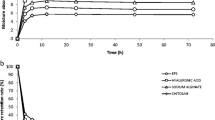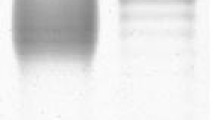Abstract
Desulfovibrio vulgaris lipopolysaccharide and outer membrane proteins (OMPs) were incorporated into vesicles ofD. vulgaris phospholipid and studied for [55Fe]binding activity. Both lipopolysaccharide and an extract of two major OMPs caused large increases in55Fe uptake over control (phospholipid only) vesicles. CommercialSalmonella typhimurium lipopolysaccharide gave a similar result, but the effect was inhibited by calcium ions; this was not the case forDesulfovibrio. The lipid A portion ofS. typhimurium lipopolysaccharide had a high iron-binding ability, whereasDesulfovibrio lipid A iron binding was little different from control values;D. vulgaris lipopolysaccharide thus has a specific iron-binding site within its polysaccharide side chain.
Similar content being viewed by others
Literature Cited
Bligh EG, Dyer WJ (1959) A rapid method for total lipid extraction and purification. Can J Biochem Physiol 37:991–997
Bradley G (1985) An investigation into the structure and functional aspects of the cell wall ofD. vulgaris. Ph.D. thesis (C.N.A.A.), City of London Polytechnic, London
Bradley G, Gaylarde CC (1986) Influence of iron on outer membrane components ofD. vulgaris. Curr Microbiol 13:37–42
Bradley G, Gaylarde CC, Johnston JM (1984) A selective interaction between ferrous ions and lipopolysaccharide inD. vulgaris. J Gen Microbiol 130:441–444
DePamphilis ML (1971) Dissociation and reassembly of theE. coli outer membrane and lipopolysaccharide: their reassembly on to flagellar basal bodies. J Bacteriol 105:1184–1199
Galanos C, Luderitz O (1975) Electrodialysis of lipopolysaccharides and their conversion to uniform salt forms. Eur J Biochem 54:603–610
Hamilton WA (1983) Sulphate-reducing bacteria and the offshore oil industry. Trends Biotechnol 1:36–40
King RA, Geary D (1980) Corrosion hazards of offshore pipelines and risers. Corrosion Prev Control 27:5–9
Leive L, Shoucin VK, Mergenhagen SE (1968) Physiological, chemical and immunological properties of lipopolysaccharide released fromE. coli by EDTA. J Biol Chem 243:6384–6391
Lowry OH, Rosebrough NJ, Farr AL, Randall RJ (1951) Protein measurement with the Folin phenol reagent. J Biol Chem 193:265–275
McIntosh MA, Earhart CF (1976) Effect of iron on the relative abundance of two large polypeptides in theE. coli outer membrane. Biochem Biophys Res Commun 70:315–322
Meyer JM, Mock M, Abdallah MA (1979) Effect of iron on the protein composition of the outer membrane of a fluorescent pseudomonad. FEMS Lett 5:395–398
Minnikin DE, Alshamaony L, Goodfellow M (1975) Differentiation of Mycobacteria, Nocardia and related taxa by thin layer chromatographic analysis of whole organism methanolysates. J Gen Microbiol 88:200–204
Muhlradt PF, Menzel J, Golecki JR, Speth V (1973) Sites of export of newly synthesised lipopolysaccharide on the bacterial surface. Eur J Biochem 35:471–481
Nixdorff K, Fitzer H, Gmeiner J, Martin HH (1977) Reconstitution of model membranes from phospholipid and outer membrane proteins ofProteus mirabilis. Role of proteins in the formation of hydrophilic pores and the protection of membranes against detergents. Eur J Biochem 81:63–69
Page WJ, von Tigerstrom M (1982) Iron and molybdenum respressible outer membrane proteins in competentAzotobacter vinelandii. J Bacteriol 151:237–242
Postgate JR (1984) The sulphate-reducing bacteria. Cambridge: Cambridge University Press
Schindler M, Osborn MJ (1979) Interaction of divalent cations and polymixin B with lipopolysaccharide. Biochemistry 18:4425–4430
Soimajarvi J, Pursiainen M, Korhonen J (1978) Sulphatereducing bacteria in paper waters and in suction roll preparations. Eur J Appl Microbiol Biotechnol 5:87–93
Westphal O, Jann K (1965) Bacterial lipopolysaccharides. Extraction with phenol/water and further applications of the procedure. Methods Carbohydr Chem 5:83–91
Zey P, Jackson S (1973) Conditions that affect the colourimetric analysis of LPS fromE. coli andTreponema pallidum. Appl Microbiol 26:129–133
Author information
Authors and Affiliations
Rights and permissions
About this article
Cite this article
Bradley, G., Gaylarde, C.C. Iron uptake byDesulfovibrio vulgaris outer membrane components in artificial vesicles. Current Microbiology 17, 189–192 (1988). https://doi.org/10.1007/BF01589450
Issue Date:
DOI: https://doi.org/10.1007/BF01589450




